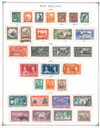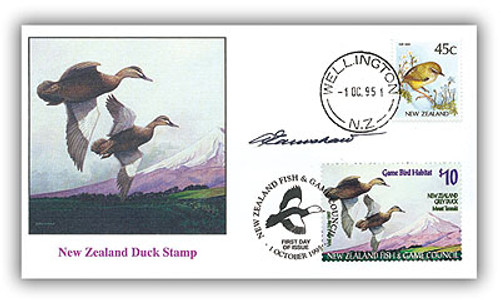
# MCC437 - 1882-2004 New Zealand
Issue Dates: 1882-2004
Scott Catalogue Value: $1,310.30
Mystic Price: $850.00
You Save: $460.30
Large New Zealand collection contains 1,303 stamps on approximately 75 Scott album pages. Blend of mint and postally used stamps with many sets. Features many early stamps. Highlights include Official and Semi-postal issues plus a few Ross Dependency stamps.
New Zealand, a remote country in the South Pacific, is about the size of Colorado. Located approximately 1200 miles southeast of Australia, it actually consists of three main islands: North Island, South Island, and Stewart. Stewart, the smaller of the three islands has fewer than 600 people living on it.
Abel Tasman, a sea captain for the Dutch East India Company, sighted the islands in 1642. He named the islands New Zealand. No Europeans actually visited the islands until the British navigator Captain James Cook rediscovered them in 1769. By the late 18th and early 19th centuries other European settlers arrived, attracted by whaling, seal hunting, and lumber industries. The Maoris, Polynesian tribes inhabiting North Island, resisted these early colonists, but were eventually defeated. In 1907, New Zealand was made an independent dominion of the United Kingdom.
Today, descendants of the first European settlements and the Maoris live in peace. Maoris make up less than 10% of the current population. The remaining 90% are Irish, English, Scotch, and Welsh. Not surprisingly, many British traditions and customs are followed.
New Zealand enjoys one of the highest standards of living in the world. The average person earns about as much as a middle-class U.S. citizen, however, food, shelter, and clothing are much cheaper than in the United States. Citizens also benefit from a progressive social welfare system. One of the first countries to offer old-age pensions and social security to its citizens, New Zealand was also the first country to give women the right to vote in 1893.
New Zealand has its own mountain range called the Southern Alps, which lie on South Island. On the west side of the mountains is a forested strip of land called the westland, where most of the lumber industry occurs. Because of the mountains and forests, only a small area on the east side of the Alps, called the Canterbury Plains, is suitable for cultivation. Here farmers raise sheep and cattle to produce New Zealand's number one cash crops of wool and dairy products. Despite the small amount of good, usable land, New Zealand farmers have a reputation for bumper crops and high quality products.
New Zealand has a moderate climate. Even in winter temperatures rarely drop below 32 degrees. Because it lies south of the Equator, New Zealand's seasons and climate conditions are just the opposite of the United States.
Issue Dates: 1882-2004
Scott Catalogue Value: $1,310.30
Mystic Price: $850.00
You Save: $460.30
Large New Zealand collection contains 1,303 stamps on approximately 75 Scott album pages. Blend of mint and postally used stamps with many sets. Features many early stamps. Highlights include Official and Semi-postal issues plus a few Ross Dependency stamps.
New Zealand, a remote country in the South Pacific, is about the size of Colorado. Located approximately 1200 miles southeast of Australia, it actually consists of three main islands: North Island, South Island, and Stewart. Stewart, the smaller of the three islands has fewer than 600 people living on it.
Abel Tasman, a sea captain for the Dutch East India Company, sighted the islands in 1642. He named the islands New Zealand. No Europeans actually visited the islands until the British navigator Captain James Cook rediscovered them in 1769. By the late 18th and early 19th centuries other European settlers arrived, attracted by whaling, seal hunting, and lumber industries. The Maoris, Polynesian tribes inhabiting North Island, resisted these early colonists, but were eventually defeated. In 1907, New Zealand was made an independent dominion of the United Kingdom.
Today, descendants of the first European settlements and the Maoris live in peace. Maoris make up less than 10% of the current population. The remaining 90% are Irish, English, Scotch, and Welsh. Not surprisingly, many British traditions and customs are followed.
New Zealand enjoys one of the highest standards of living in the world. The average person earns about as much as a middle-class U.S. citizen, however, food, shelter, and clothing are much cheaper than in the United States. Citizens also benefit from a progressive social welfare system. One of the first countries to offer old-age pensions and social security to its citizens, New Zealand was also the first country to give women the right to vote in 1893.
New Zealand has its own mountain range called the Southern Alps, which lie on South Island. On the west side of the mountains is a forested strip of land called the westland, where most of the lumber industry occurs. Because of the mountains and forests, only a small area on the east side of the Alps, called the Canterbury Plains, is suitable for cultivation. Here farmers raise sheep and cattle to produce New Zealand's number one cash crops of wool and dairy products. Despite the small amount of good, usable land, New Zealand farmers have a reputation for bumper crops and high quality products.
New Zealand has a moderate climate. Even in winter temperatures rarely drop below 32 degrees. Because it lies south of the Equator, New Zealand's seasons and climate conditions are just the opposite of the United States.










